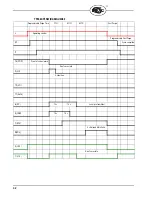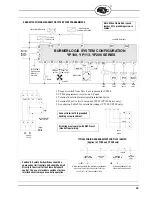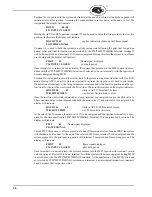
25
®
The LEARN process is not subject to the 8 hour burn-in and therefore will always be available.
If the LEARN process is activated at STANDBY, the LEARN process will involve both pilot and
main flame. If the LEARN process is activated during the main firing period (AUTO) the LEARN
process will only involve the main flame learn. That is, during this LEARN process in AUTO, the
thresholds for pilot flame are not affected. The advantage of the separate learn is to take into effect
the possibility that the characteristics of the main flame might change due to changes in background
conditions after a long firing period.
Once a LEARN process is activated, it cannot be undone. Also, if a LEARN cannot be com-
pleted in the subsequent burner cycle due to burner interruptions or a flame fail, the LEARN
process will continue to remain active.
During PTFI, the LEARN process takes place during the last 3 seconds of the pilot period and is
indicated on the display:
PTFI 80
LEARNING FLAME
During AUTO the LEARN process takes place during the first 3 seconds of AUTO and is indicated
on the display
HOLD
80
LEARNING FLAME
After the LEARN process is completed the flame signal displayed value is normalized to a value of
32.
AUTO
32
FLAME SIGNAL
Therefore during the next pilot trail for ignition period the expected value of flame signal should be
32.
PTFI 32
FLAME SIGNAL
Any increases or decreases in amplitude or radiation may cause the displayed value to increase or
decrease. Should the displayed value continue to decrease, possibly due to changing conditions in
the boiler such as a bright background causing a reduction in scanner sensitivity, it is suggested to
activate a new DO IR LEARN during AUTO. Without shutting the burner off, scroll to PROGRAM
SETUP and in that sub-menu, modify DO IR LEARN to YES. The LEARN function will be acti-
vated immediately. [Note: The display will continue to indicate YES even though the LEARN pro-
cess is complete. Pressing the up arrow and then down arrow will indicate the updated state of DO
IR LEARN.]
The type of burner and fuel will affect the amplitude and radiation characteristics of the flame. Gas-
eous flames tend to have low amplitude and radiation whereas oil flames have a high amplitude and
radiation. On burners having the option to fire both gaseous and oil fuels, it is recommended the
LEARN process be performed on gas.
An abrupt change in the background radiation (brightness) may be an indication that the firing char-
acteristics of the fuel have changed. In oil fired units this may be caused by a sudden interruption in
the oil delivery. The BurnerLogix utilizes this information to make a decision to keep the burner on
line or force a shut down. If the background radiation (brightness) changes downward by 20% in a
25 msec period and stays at this level for 1 FFRT, the decision to shut down will be made. Also, if
the detected flame signal average falls below 20% of the Learned On value, the burner will also be
shut down.
















































